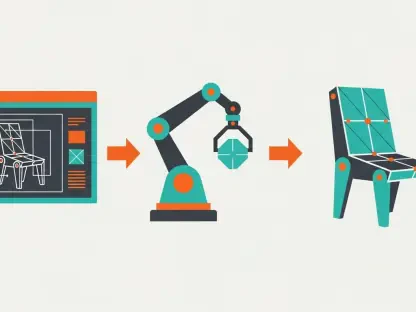The Surge of AI and the Infrastructure Imperative
In an era where artificial intelligence is reshaping industries at an unprecedented pace, a staggering reality emerges: the global AI market is projected to grow at a compound annual rate of over 37%, demanding an infrastructure backbone robust enough to support this explosive expansion. This rapid evolution places immense pressure on tech giants to build and scale the systems that power AI, from data centers to specialized hardware, ensuring that innovation does not outstrip capacity. The critical role of infrastructure in sustaining AI’s trajectory cannot be overstated, as it underpins everything from enterprise solutions to consumer applications. This analysis delves into Google’s bold plans for AI infrastructure growth, examines industry-wide challenges and investment trends, incorporates expert insights, and explores the future implications of these strategies for the broader tech landscape.
Google’s Aggressive Push for AI Capacity
Doubling Down on Server Growth
Google has set an ambitious target to double its server capacity every six months, aiming for a monumental 1000x increase over the next four to five years, as announced by Amin Vahdat, head of AI infrastructure, during a recent all-hands meeting. This plan reflects a clear intent to dominate the AI space by ensuring the computational resources necessary to meet soaring demand. Supported by Alphabet’s financial muscle, with a capital expenditure forecast of $93 billion following strong quarterly performance, Google is well-positioned to execute this vision. The company’s cloud business, growing at an impressive 33% annually, further fuels the urgency and feasibility of this massive scaling effort.
Harnessing Cutting-Edge Technology
Central to Google’s strategy is the deployment of advanced hardware, such as the seventh-generation Tensor Processing Unit, designed to optimize performance for AI workloads. Alongside this, the focus on streamlined large language models (LLMs) ensures that enterprise clients adopting AI solutions experience enhanced efficiency and cost-effectiveness. These technological advancements not only bolster Google’s cloud operations but also deliver tangible value to users across diverse sectors, from healthcare to finance, by enabling faster and more reliable AI-driven insights.
Competitive Edge Through Expansion
This unprecedented capacity expansion positions Google to seize significant market opportunities, particularly in outpacing competitors who may struggle to match such aggressive growth. By building a robust infrastructure foundation, Google can cater to the escalating needs of businesses integrating AI, thereby strengthening its foothold in the cloud computing arena. This strategic move also serves as a signal to the industry that infrastructure readiness is a key differentiator in the race to lead AI innovation.
Industry-Wide Recognition: Infrastructure as the Core Barrier
Persistent Obstacles to AI Progress
Across the globe, a striking statistic reveals that 80% of AI projects falter not due to shortcomings in technology but because of inadequate infrastructure, as highlighted in recent industry reports. Challenges such as outdated legacy systems, insufficient real-time and edge computing capabilities, and fragmented data silos create significant roadblocks. These systemic issues often result in delayed project timelines, limited data accessibility, and ultimately, AI models that fail to deliver actionable results.
Consequences of Infrastructure Gaps
The ripple effects of these infrastructure limitations are profound, impacting organizations’ ability to scale AI initiatives effectively. Delays in data processing hinder timely decision-making, while siloed systems prevent the seamless integration necessary for comprehensive AI solutions. Experts like Markus Nispel of Extreme Networks emphasize that without addressing these foundational weaknesses, businesses risk stalling their digital transformation efforts, underscoring the urgency for systemic upgrades.
Hyperscalers’ Unprecedented Investment Surge
Major tech providers, including Google, Microsoft, Amazon, and Meta, are responding to these challenges with a collective capital expenditure projected to exceed $380 billion this year alone. This massive investment wave reflects a unified belief in the mantra “if we build it, they will come,” suggesting that robust infrastructure is the gateway to unlocking AI’s full potential. Similar strategies across these hyperscalers, such as expanding data center networks and enhancing computational resources, illustrate a shared commitment to overcoming the current bottlenecks.
Voices from the Field: Expert Insights on Infrastructure Needs
Risks of Underinvestment
Amin Vahdat has openly cautioned against the dangers of under-investing in compute resources, noting that Google’s cloud business could miss substantial growth opportunities without sufficient capacity. This perspective highlights the direct link between infrastructure readiness and market performance, particularly in a sector where demand continues to surge. Vahdat’s insights serve as a reminder that scaling infrastructure is not merely a technical necessity but a strategic imperative.
Bridging Fragmentation Gaps
Markus Nispel advocates for the development of agile, unified systems positioned close to data sources to address the pervasive issue of fragmentation. Such proximity ensures faster processing and more effective AI deployment, tackling the inefficiencies caused by disparate systems. His emphasis on integration near the point of computation offers a practical pathway to overcoming the structural challenges many organizations face.
Infrastructure Over Algorithms
A broader consensus among industry leaders points to infrastructure as the true linchpin for scaling AI solutions, rather than relying solely on algorithmic advancements. This shift in focus acknowledges that even the most sophisticated models are rendered ineffective without the underlying systems to support them. The collective viewpoint reinforces the need for sustained investment in capacity and connectivity to drive the next wave of AI breakthroughs.
Looking Ahead: Implications of AI Infrastructure Growth
Transforming Accessibility and Innovation
Google’s pursuit of a 1000x capacity increase over the coming years could fundamentally alter the landscape of AI accessibility, making powerful tools available to a wider range of businesses and developers. This expansion is likely to accelerate innovation by lowering barriers to entry, enabling smaller enterprises to leverage AI in ways previously reserved for tech giants. The democratization of such capabilities may spur a new era of creative applications across industries.
Balancing Benefits and Risks
While the industry stands to gain from faster AI adoption and more robust enterprise solutions, potential challenges loom on the horizon, including market saturation or the risk of an “AI bubble” within the next six months. Over-investment could lead to underutilized resources if demand does not keep pace with supply, creating financial strain for some players. Navigating this delicate balance will be critical to sustaining long-term growth without triggering short-term setbacks.
Addressing Systemic Gaps
Beyond immediate market dynamics, advancements in infrastructure hold the promise of bridging current gaps in data handling and real-time computing, areas that have long hindered AI progress. However, the risk of technological obsolescence remains, as rapid innovation could render today’s investments outdated sooner than expected. Forward-thinking strategies that anticipate these shifts will be essential to ensuring that infrastructure remains a catalyst rather than a constraint.
Reflecting on the Path Forward
Looking back, Google’s audacious strategy to scale AI infrastructure, alongside the industry’s collective drive to invest heavily in foundational systems, marked a turning point in addressing the critical bottlenecks that once impeded AI advancement. The recognition of challenges like legacy systems and data silos as central hurdles spurred a unified effort among tech leaders to prioritize capacity over mere technological novelty. Moving forward, stakeholders were encouraged to focus on actionable solutions, such as fostering partnerships for shared infrastructure resources and investing in modular systems that adapt to evolving needs. This emphasis on scalability and efficiency laid the groundwork for a future where AI could thrive without the constraints of yesterday’s limitations, offering a blueprint for sustained innovation.









